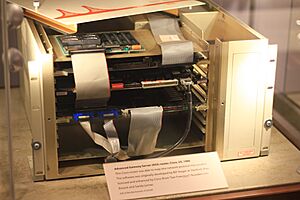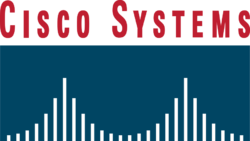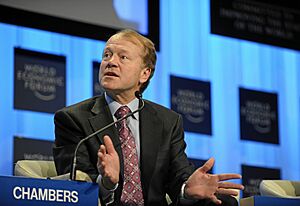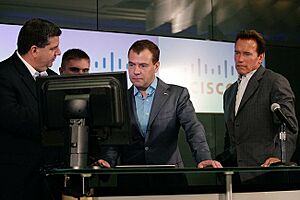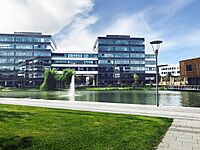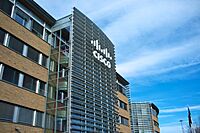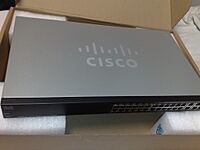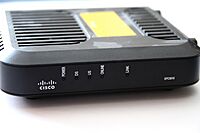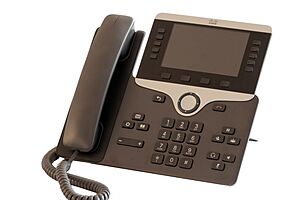Cisco facts for kids
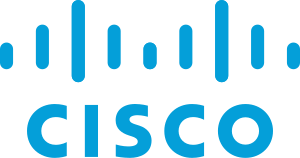 |
|
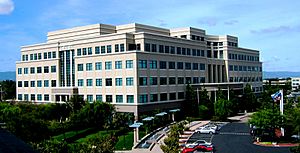
Building 10 of the Cisco San Jose Main Campus
|
|
| Public | |
| Traded as | |
| ISIN | ISIN: [https://isin.toolforge.org/?language=en&isin=US17275R1023 US17275R1023] |
| Industry | |
| Founded | December 10, 1984 in San Francisco, California, U.S. |
| Founders | |
| Headquarters |
,
U.S.
|
|
Area served
|
Worldwide |
|
Key people
|
|
| Products | List of Cisco products |
| Revenue | |
|
Operating income
|
|
|
|
| Total assets |
|
| Total equity |
|
|
Number of employees
|
90,400 (2024) |
| Footnotes / references Financials as of July 27, 2024[update]. |
|
Cisco Systems, Inc. (also known as Cisco) is a big American company. It makes technology that helps computers and devices connect and talk to each other. Cisco creates networking hardware (like routers and switches), software, and other high-tech products.
The company is based in San Jose, California. Cisco is known for its work in areas like the Internet of things (IoT), which connects everyday objects to the internet. They also work on internet security, videoconferencing (like Webex), and managing energy use.
Cisco Systems was started in December 1984 by Leonard Bosack and Sandy Lerner. They were computer scientists at Stanford University. They helped connect computers at Stanford and came up with the idea of using a special router to link computers far apart.
The company became public in 1990. By 2000, Cisco was one of the most valuable companies in the world. Its stock is traded on the Nasdaq stock exchange.
Contents
History of Cisco Systems
How Cisco Started (1984–1995)
Cisco Systems was founded in December 1984 by Sandy Lerner and her husband Leonard Bosack. Sandy managed computer systems for Stanford University's business school. Leonard was in charge of the computer science department's computers at Stanford.
Cisco's first product came from technology used at Stanford University. In the early 1980s, people at Stanford linked all the school's computers together. They used a special box called the "Blue Box" that acted like a router. This box helped different computer systems communicate.
In 1987, Stanford University allowed Cisco to use its router software and computer parts. The name "Cisco" comes from "San Francisco". The company's logo looks like the two towers of the Golden Gate Bridge.
Cisco Systems became a public company on February 16, 1990. This meant people could buy shares of the company. Cisco was one of the first companies to sell successful routers that could connect many different types of networks. Their early devices were flexible and could be updated with new software. This helped them keep up with changing technology.
In 1995, John T. Chambers became the CEO of Cisco.
Internet Growth and New Technologies (1996–2005)
The Internet Protocol (IP) became very popular in the late 1990s. Cisco made many products for the internet, becoming a big player in the market. In March 2000, Cisco was the most valuable company in the world.
Other companies started making new ways to process internet data faster. Cisco responded by developing its own special chips and fast processing cards. In 2004, Cisco also started using new high-end hardware and software.
Connecting People (2006–2012)
Around 2006, Cisco started using the shorter name "Cisco" and launched an ad campaign called "The Human Network." This was to make Cisco a more well-known brand, especially for home products.
Cisco kept improving its products for connecting networks, switching data, and security. The company also grew a lot in India. In 2009, they bought a company called Starent Networks that specialized in mobile technology.
In 2011, Cisco reduced some of its staff to lower costs. In 2013, Cisco sold its Linksys home-router business. This showed the company was focusing more on selling to businesses instead of individual customers.
Recent Developments (2013–Present)
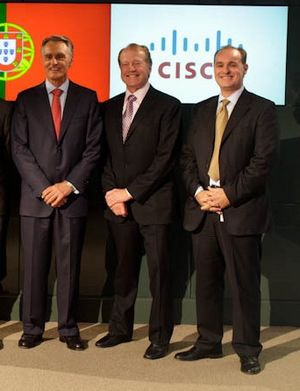
In 2013, Cisco bought Sourcefire, a company focused on cybersecurity. Cisco also announced it would reduce about 4,000 jobs. At the end of 2013, Cisco's sales were lower in some markets.
In April 2014, Cisco started funding new companies that focus on the Internet of Things. Later that year, the company announced more staff reductions.
On May 4, 2015, John Chambers stepped down as CEO. Chuck Robbins became the new CEO. Cisco also sold its TV set-top-box business. This was part of Cisco's plan to focus more on cloud-based products for businesses.
In 2016, Cisco invested in VeloCloud, a company that helps manage networks using software. In 2017, Cisco launched Cisco Umbrella, a cloud-based service for safe internet access. In December 2017, Chuck Robbins also became the chairman of the company.
In 2019, Cisco bought CloudCherry, a company that helps manage customer experiences. They also acquired Voicea, an artificial intelligence company. Cisco also introduced a new powerful chip called "Silicon One."
In 2022, Cisco stopped selling its equipment in Russia due to the conflict in Ukraine. In February 2024, Cisco announced it would reduce about 4,000 employees. In March 2024, Cisco received approval to buy the cybersecurity company Splunk for $28 billion. This was Cisco's biggest purchase ever. In April 2024, Cisco's CEO, Chuck Robbins, met with Pope Francis and signed an agreement about using AI responsibly.
Cisco's Financials
For the year 2023, Cisco earned about $12.6 billion. Its total yearly income was about $57 billion. Cisco's shares were worth over $43 each in September 2018.
How Cisco is Organized
Companies Cisco Has Bought
Cisco has bought many different companies over the years. This helps them get new products and talented people. For example, in 2003, Cisco bought Linksys, which made home routers. In 2010, they bought Tandberg, a company known for video conferencing. These purchases helped Cisco offer more products and services.
In 2007, Cisco bought IronPort, a company known for email security. This helped Cisco improve its security products. In 2012, Cisco acquired NDS Group, a TV software developer.
Cisco has also bought many cybersecurity companies, like Sourcefire in 2013 and Splunk in 2023. These acquisitions help Cisco protect computer networks from threats.
Where Cisco is Located
Cisco's main office is in San Jose, California. They have many buildings there. Over 15,000 employees work at this campus. Cisco's second largest campus in the United States is in Research Triangle Park in North Carolina.
Cisco has more than 200 offices in over 80 countries around the world. In 2021, Cisco announced that its employees could choose to work remotely permanently.
Cisco's Products and Services
Cisco makes products and offers services for different types of customers. These include large companies, internet service providers, and small businesses.
Cisco's main technology areas are:
- Networking: This includes things like Ethernet, wireless, and mobile connections.
- Security: Protecting networks and data from cyber threats.
- Collaboration: Tools for people to work together, like voice calls, video calls, and sharing data.
- Data Center: Equipment for storing and managing large amounts of data.
- Internet of Things (IoT): Connecting everyday objects to the internet.
Cisco is very popular in the Asia-Pacific region, especially in Australia.
Voice over IP (VoIP) Services
Cisco is a big provider of Voice over IP (VoIP) services for businesses. VoIP lets you make phone calls over the internet instead of traditional phone lines.
Network Emergency Response
Cisco has special vehicles called Network Emergency Response Vehicles (NERVs). These vehicles are used during natural disasters and other emergencies. Cisco employees deploy them to help.
The NERVs are like mobile command centers. They provide internet, phone, and video services in disaster areas. They can get set up and working very quickly. These vehicles have helped in many disasters, like hurricanes and earthquakes.
Cisco also has smaller, portable communication kits for emergencies outside of North America. These kits helped after earthquakes in Haiti and New Zealand.
Certifications and Training
Cisco offers special training and certifications for people who want to work with their products. These certifications show that someone has the skills to design, build, and manage computer networks.
Cisco also has a program called the Cisco Networking Academy. Schools can become members and offer courses to students. This helps train future technology experts. Cisco is involved in technical education in 180 countries through this program.
Company Achievements
Awards and Recognition
Cisco products, like their IP phones and video conferencing systems, have appeared in movies and TV shows.
Cisco has won many awards. In 2002–03, they received the Ron Brown Award. This is a U.S. presidential honor for companies that have great relationships with their employees and communities. In 2019, Cisco was ranked number one on Great Place to Work's list of the World's Best Workplaces. Fortune magazine also ranked Cisco Systems as one of the top companies to work for in 2020.
Cisco is also a leader in getting patents related to network security. This means they have many new inventions in that area.
Sponsorships
In February 2021, Webex (a Cisco product) partnered with McLaren Racing. Webex became the official collaboration partner for the racing team. The next year, Cisco became the official technology partner for McLaren. In October 2023, Cisco became a main partner for the McLaren F1 Academy program. Cisco's logo is on Bianca Bustamante's car and race suit for the 2024 F1 Academy season.
See also
 In Spanish: Cisco Systems para niños
In Spanish: Cisco Systems para niños
- Cisco certifications
- Cisco IOS
- Packet Tracer
- Cisco Catalyst
- Cisco DevNet
- Cisco Express Forwarding
- Cisco Discovery Protocol
- Cisco Security Agent
- Cisco Systems VPN Client
- Cisco WebEx
- Cisco Field


